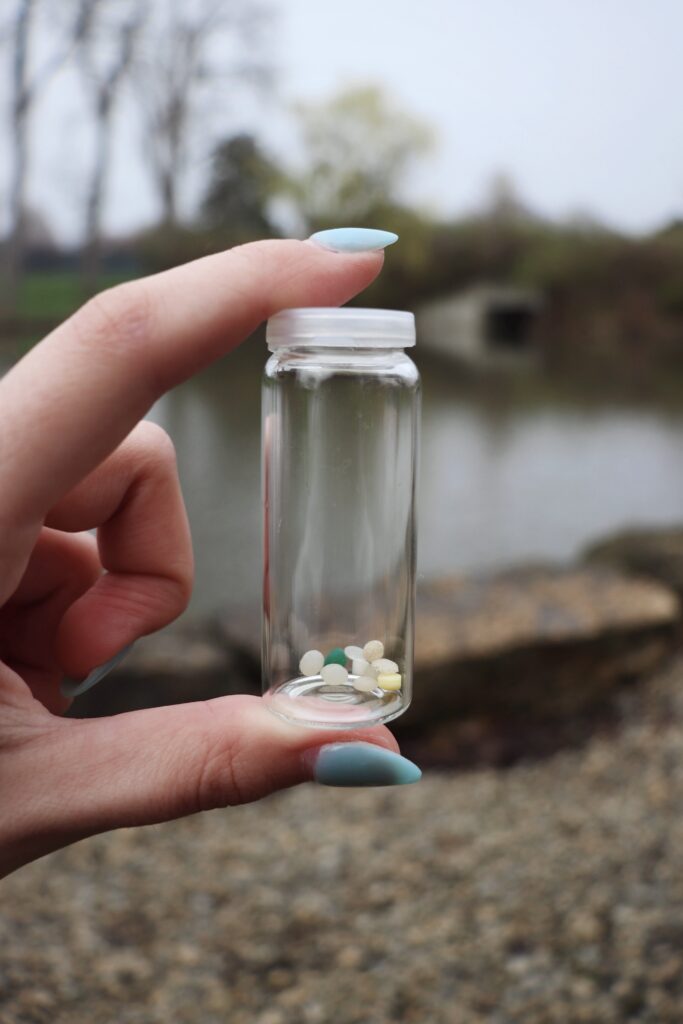Less than a mile south of Ball State’s campus lies the White River where over 65 tons of trash have been removed in the past 13 years, according to the Muncie Sanitary District.
All around Ball State’s campus, located near trash cans, are bins lined with bright blue bags, serving as visual reminders to students that they can choose to recycle any paper, plastics, and styrofoam. However, If the blue bins are contaminated with too much non-recyclable material, it is rejected and sent to the trash anyway, according to Ball State University’s website.
The website clarifies that Ball State’s relationship with recycling is complicated. While the university encourages students to recycle, it emphasizes that if any of the materials in the recycling bins are contaminated with leftover foods, liquids, or chemicals, they will be rejected from the recycling process.
David Williams, a senior animation student at Ball State joined an organization called the Global Reporting Initiative (GRI), along with a handful of other students. The organization’s mission is to host audits, assessing Ball State’s sustainability using a system called S.T.A.R.S. — Sustainability Tracking Assessment and Rating System.
David highlights Ball State’s grade for S.T.A.R.S. is gold, which is ranked as the second-most efficient class. However, according to the ranking, there is still room for improvement.
Noteworthy Impact
Wildlife biology and conservation major Ben Jones says recycling plays a big part in how humans interact with animals’ habitats. Ben has spent years immersed in the outdoors through camping, hunting, and fishing. Although he’s enjoyed several remarkable, up-close encounters in nature, he expresses the upsetting reality of litter being common throughout the landscapes he has explored, including a recent trip he took to Florida.
“There was litter and trash everywhere,” Ben says. “I saw a crab carrying a piece of trash with him like a bottle cap … I thought that was a little sad.”
Ben brings attention to the ample amount of plastics essential to our everyday lives. This includes temporary items such as plastic silverware, sunglasses, phone cases, straws, plastic wrap, toothbrushes, and credit cards.
“If you think about it all … where is that going to go?” He asks. “A lot of it is going to end up in the ocean, unfortunately.”
For those residing in the Midwest, like Ben, it’s easy to overlook the major impact these plastics have on oceanic environments, considering their disconnection from coastal biomes. However, copious amounts of litter still impact Midwest communities.
According to the Rochester Institute of Technology, more than 22 million pounds of plastic pollution end up in the Great Lakes every year, which provide drinking water for 40 million people.
Mathew Simpson, assistant lecturer of natural resources and environmental management at Ball State University, studies pre-production microplastics and their distribution across various ecosystems.
According to the National Oceanic and Atmospheric Administration, microplastics are tiny plastic particles, less than 5 millimeters in size, that originate from either the breakdown of larger plastic items or are intentionally manufactured as small particles.

Antonia Liakas, Ball Bearings
One of Simpson’s main concerns is that plastic particles are being lost in transit between facilities and enter the environment. Simpson describes a time he visited the Great Lakes. Around the coastline, he says “every step you take, you see them on the beach.”
Muncie is no exception. A study conducted by Notre Dame doctoral student Blessing Yaw Adjornor and various Ball State professors, found 2,499 microplastic particles per kilogram of sediment in the White River.
“There is no place on this planet that microplastic has not been discovered,” Simpson says.
Whether or not the plastic is on a micro-scale, it is ever-present in Muncie. However, Simpson asserts if everyone takes a small step to recycle, it can positively impact the planet in large ways.
Tricky Territory
Recycling has proven to be much more complex than some might think, David says.
“The reason why is not because Ball State is not trying to recycle,” suggests David. “It’s that the recycling system, almost nationwide, is confusing.”
David also suggests that recycling is very “nuanced” and students that are new to campus may struggle with getting into the habit of recycling. He emphasizes that it’s difficult to get it right every single time.
Almost every one of these reusables require a bit of prep before tossed in the recycle. Food and beverage containers must be emptied completely, rinsed, and dried prior to entering the bin, otherwise rotting foods or saturating liquids are no longer suitable for the recycling process.
Different organizations such as Republic Services provide helpful tips on how to contribute from home. They encourage consumers to identify if the item can be reused or broken down in a landfill. Most recycling services accept plastic, cardboard, glass, metal, aluminum, and paper.
The same goes for cleaning products or detergent containers. It is crucial for them to be free of any soapy, chemical residue. Oftentimes, recyclable components are accompanied by plastic or paper labels that need to be cut or peeled off prior to the bin.
The Muncie Sanitary District (MSD) also provides a “how-to” guide for recycling where they not only share what items they will recycle, but they also share how the recycling of one item can positively impact the environment.
Notably, the MSD only recycles number one and two plastics and discourages recycling ceramic mugs, plates, crystal, and window glass.
While recycling may take conscious decision making, David stresses the importance of learning the ritual of recycling.
“Education is the first step,” David says.
Sources: Muncie Sanitary District, Rochester Institute of Technology, National Oceanic and Atmospheric Administration, Transport and Deposition of Microplastics, Republic Services


